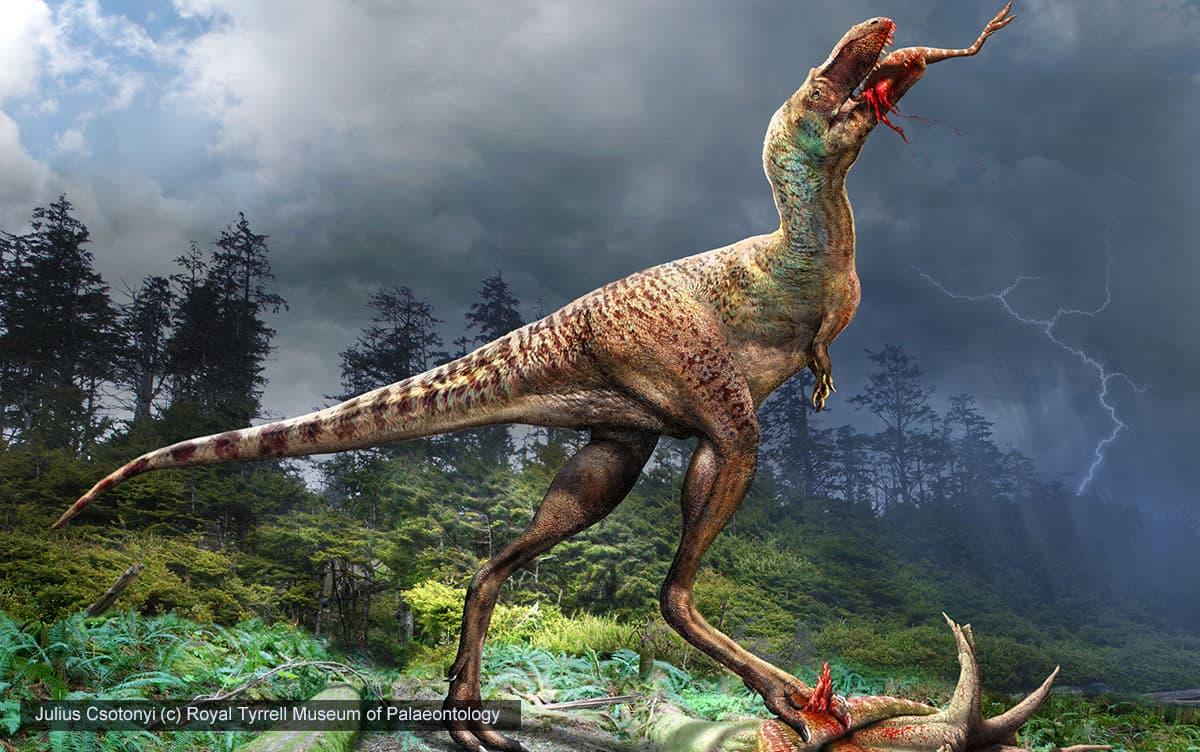Research News
First Discovery of a Tyrannosaur Skeleton with Well-Preserved Stomach Contents

A research team including the University of Tsukuba has made a significant discovery of a nearly intact juvenile Gorgosaurus skeleton, a species from the family Tyrannosauridae, one of the apex carnivorous dinosaur groups. This skeleton was unearthed from the Late Cretaceous deposits in Canada. Interestingly, the skeleton contained well-preserved stomach contents, primarily consisting of the legs of two small dinosaurs. This finding suggests that the juvenile Gorgosaurus preferred preying on small-bodied dinosaurs. It provides evidence supporting the hypothesis that members of the Tyrannosauridae underwent dietary and foraging style changes as they matured.
Tsukuba, Japan—The Tyrannosauridae family were enormous carnivorous dinosaurs that dominated terrestrial ecosystems approximately 80-66 million years ago during the Late Cretaceous Period. They underwent significant physical changes as they grew, transitioning from agile and slender forms to stout and robust ones. This transformation suggests a shift to higher ecological niches as their prey changed with their developmental stage. While it is known that adult tyrannosaurs fed on large herbivorous dinosaurs like Triceratops, the diet of juvenile tyrannosaurs has remained elusive.
In a breakthrough discovery, researchers found a nearly intact juvenile Gorgosaurus skeleton, a species of Tyrannosauridae that retained well-preserved stomach contents in the abdominal cavity and demonstrated the feeding preferences of juvenile tyrannosaurs. The stomach contents consisted of the hind limbs and other remains of two small juvenile dinosaurs known as Cytipes. Interestingly, the two Cytipes were preyed upon at different times, as indicated by their placement in the abdominal cavity and the degrees of digestion were different. This finding suggests that juvenile Tyrannosauridae preferentially preyed on small dinosaurs and had a diet that differed from adults, which primarily preyed on large herbivorous dinosaurs. Therefore, these findings support the hypothesis that the diet and ecological niches of Tyrannosauridae changed as they grew, providing valuable insights into the life history of these fascinating creatures.
###
This work was supported by the Royal Tyrrell Museum Cooperating Society (F.T.); Natural Sciences and Engineering Research Council Discovery Grants (RGPIN 04854 to D.K.Z. and RGPIN 04715 to P.J.C.); Japan Society for the Promotion of Science (JSPS) KAKENHI (JP22K14133 to K.T. and JP23K03557 to Y.K.); Eyes High Doctoral Recruitment Scholarship, University of Calgary (J.T.V.); Izaak Walton Killam Memorial Scholarship (J.T.V.); and National Science Foundation grants (EAR 1226730 and EAR 1736515 to G.M.E.).
Original Paper
- Title of original paper:
- Exceptionally preserved stomach contents of a young tyrannosaurid reveal an ontogenetic dietary shift in an iconic extinct predator
- Journal:
- Science Advances
- DOI:
- 10.1126/sciadv.adi0505
Correspondence
Assistant Professor TANAKA Kohei
Institute of Life and Environmental Sciences, University of Tsukuba
Professor Yoshitsugu Kobayashi
Hokkaido University Museum
Related Link
Institute of Life and Environmental Sciences



